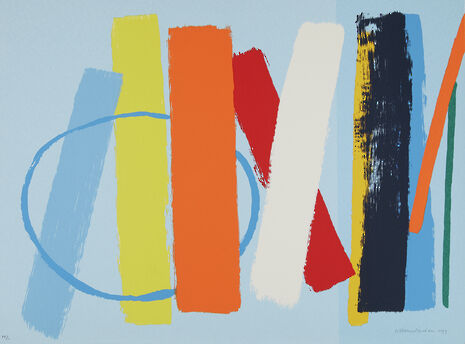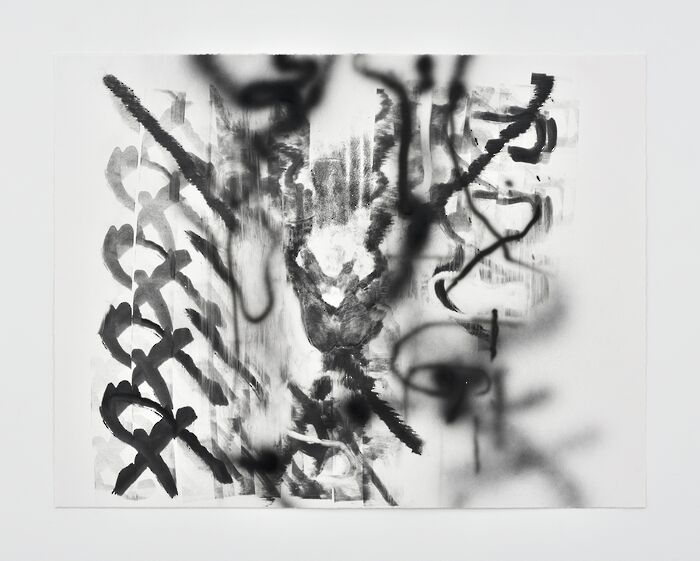Kip Gresham: The Art of Collaboration interview
Esmee Wright sits down with Master Printer Kip Gresham to discuss his new exhibition at the Heong Gallery

Kip Gresham, Master Printer at the Cambridge based The Print Studio, is the subject of a new exhibition, Kip Gresham: The Art of Collaboration at the Heong Gallery. As the name may suggest, this exhibition isn’t just a demonstration of Gresham’s skills as a Master Printer, but also of his ability to work with artists from other mediums to create beautiful collaborative prints. Gresham himself defines his job primarily as “one of working hand in hand with artists”.
We meet, both early and only slightly damp in the unexpected downpour, at a preview of his exhibition in the Heong gallery. The airy white space does well in focusing the attention on the prints themselves, often riotous with colour in comparison.
Colour is, after all, an important part of printmaking; on the preview he does point out his work with Wilhelmina Barns Graham’s Summer (Blue Light), marking it out as the ‘archetype’ that people think of when they hear “printmaking”; loud blocks of bold colour printed seemingly without organisation onto white paper.
“Once layered enough, ultramarine blue begins to turn to red; being able to expect and control this sort of reaction has created some truly amazing prints”
Gresham also discusses his work with Willard Boepple, a New Yorkbased sculptor. In an interview published on The Print Studio’s YouTube channel, Boepple describes how while working with Gresham he was “plunged into the colour”. Gresham explains how he moved from Boepple’s traditional sculptural work – who at the time primarily worked using layers of transparent resin – and how he thought “Okay, we’ll work with transparent colour and related forms, which he could and did make”.
Together Gresham and Boepple created many prints, layering colours over one another, or often the same colour over itself so many times that it began to change. As Gresham points out, knowledge of the chemistry behind the inks is vital. Once layered enough, ultramarine blue begins to turn to red; being able to expect and control this sort of reaction has created some truly amazing prints, fascinating in the way that you can see how Boepple’s sculptural style has been so well translated into what is technically a 2D piece of art.

Gresham makes clear that ‘translating’ the artistic practice between the artist’s primary medium and print is central to his work. His way of describing it is through language: “artists have their own vocabulary... each artist who arrives brings with them their thoughts. My job really is to get inside their heads and read the language from the inside, and find solutions to impossible problems”. Gresham is particularly fond of this aspect of his work, attributing to it some of his most imaginative advances in printmaking. “[Working with someone who hasn’t worked with print before] is a glorious situation. Generally whatever we do we are aware that there are performance characteristics, you know that a car won’t fly. But with an artist they don’t know that a car won’t fly”. Working with someone who is only discovering the boundaries in the world of print, and being so willing to push those boundaries even as they are discovered can, and has, lead to industry-changing innovations.
However, when talking about how his role in the creation of the artwork affects the final “ownership” of the piece itself he insists that it remains the artist’s piece. “I think the basis of this is that the work is for the artist but it only becomes complete when it is seen by somebody else and my participation in that is secondary.” As he says at the start of the tour I later join in with, “If there is a genius it is in the artist”. However, after seeing the work on display, you might feel tempted to contest this.
“The printed images on display in the Heong Gallery are certainly a testament to not only Grisham’s talent, but also his skill in working with the artists to create a beautifully diverse variety of images”
Gresham does admit that working so closely with other artists has its downsides. When it comes to making his own work it takes time to shed the heavy influences of those with whom he has collaborated. He has two pieces of his own in the exhibition both made over 40 years ago. Such is the demand for the studio's press time that, although he greatly enjoys making his own work, the moments when this is possible are infrequent.
In both the obliterated newspaper image of his own, (Paper, 1972), and Gresham's answers to my questions it is clear that there is a certain enjoyment of the perverse running through his approach to printmaking. The images he produces are original and unique. Musing that, while many consider that the potential of printmaking for mass production reduces its meaning as an art form, he enjoys the contrariness of using printing technology designed to make hundreds of copies, to make one single image. Even when the images he is producing are not wholly unique, when it is possible to create another identical print, he sees a benefit in being able to make more than one piece when many might only see an undermining of artistic substance; “The great thing about making a printed image is that if you make more than one it can be in more than one place at once and as the creator one can keep it, if one wants to sell it you still have one you can keep.”
The printed images on display in the Heong Gallery are certainly a testament to not only Grisham’s talent, but also his skill in working with the artists to create a beautifully diverse variety of images, from Stephen Chambers folk-like patterns in Manners of the Americanto Alison Wilding’s experimental Phaethon, and I would definitely advise anyone with even the slightest pretension to interest in the art world to visit this exhibition, which firmly places printmaking as a means of artistic production equal to those people may consider more ‘traditional’.
Kip Gresham: The Art of Collaboration is running until the 19th of May 2019 at the Heong Gallery, Downing College.
 News / Clare Hall spent over £500k opposing busway 24 December 2025
News / Clare Hall spent over £500k opposing busway 24 December 2025 Comment / The ‘class’ of Cambridge24 December 2025
Comment / The ‘class’ of Cambridge24 December 2025 News / Eight Cambridge researchers awarded €17m in ERC research grants27 December 2025
News / Eight Cambridge researchers awarded €17m in ERC research grants27 December 2025 News / Caius mourns its tree-mendous loss23 December 2025
News / Caius mourns its tree-mendous loss23 December 2025 Comment / League tables do more harm than good26 December 2025
Comment / League tables do more harm than good26 December 2025









